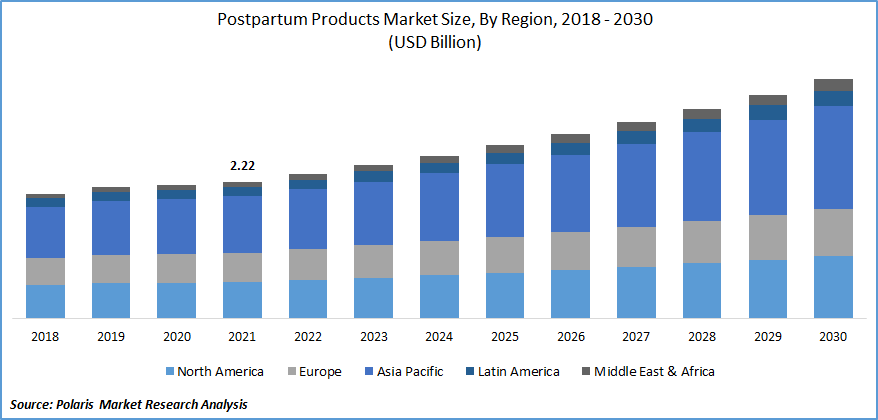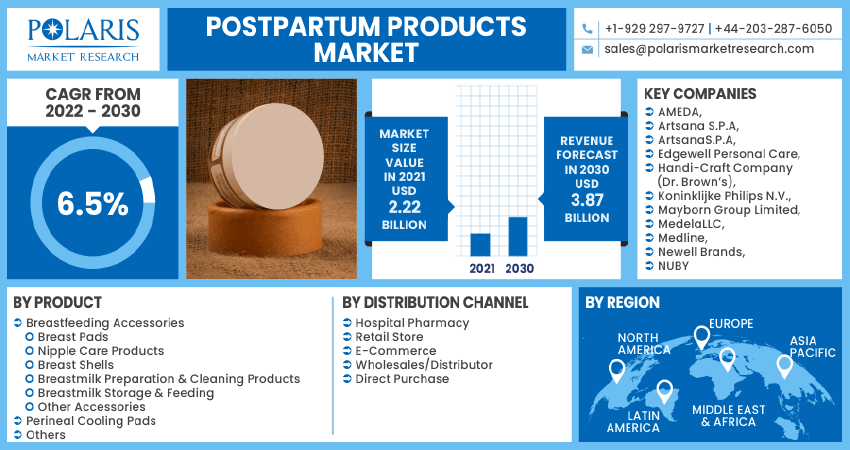
Postpartum Products Market Share, Size, Trends, Industry Analysis Report
By Products; By Distribution Channel (Hospital Pharmacy, Retail Store, E-Commerce, Wholesales/Distributor, Direct Purchase), By Region; Segment Forecast, 2022 - 2030
- Published Date:Jan-2022
- Pages: 112
- Format: PDF
- Report ID: PM2189
- Base Year: 2021
- Historical Data: 2018 - 2020
Report Outlook
The global postpartum products market was valued at USD 2.22 billion in 2021 and is expected to grow at a CAGR of 6.5% during the forecast period. The growth in the market is being driven by the rise in the number of working women around the world. As per the International Labour Organization, the current global female labor force participation rate is close to 49%. It's 75 % for men. That's a 26-percentage-point gap, with some places experiencing a margin of more than 50-percentage-points.
 Know more about this report: request for sample pages
Know more about this report: request for sample pages
In addition, women are becoming more self-sufficient and financially independent as they become more involved in the global workforce. As a result, women choose high-quality healthcare and medical items for themselves and their children. This trend is having a favorable impact on postpartum products sale.
The global postpartum products market has seen a decrease in sales over the last two years, as most participants in the industry have experienced operational challenges due to supply chain constraints due to the COVID-19 pandemic. Moreover, the closure of offline sales and distribution channels, including pharmacies, specialty stores, department stores, and hypermarkets, which account for most sales in the global postpartum products market, negatively impacted the business.

Know more about this report: request for sample pages
Industry Dynamics
Growth Drivers
The postpartum products market has observed extensive developments in the last few decades supported by various factors such as the growing burden of problems during pregnancy and rising healthcare expenditure by governmental institutions.
For instance, according to the Center for Disease Control and Prevention (CDC) data, pregnancy difficulties can be caused by pre-existing conditions or conditions that emerge during pregnancy. Because pregnancy problems include a broad spectrum of illnesses with various degrees of severity, estimating the impact of pregnancy complications on mother and newborn outcomes is difficult. The hypertensive disorders in pregnancy include gestational hypertension, pre-eclampsia, and eclampsia, among others.
Further, as per the Centers for Medicare & Medicaid Services, from 2019 to 2028, national health spending is expected to grow at 5.4 %, reaching USD 6.2 trillion. The health contribution of the economy is expected to rise from 17.7% in 2018 to 19.7% in 2028, as national health expenditures are expected to grow 1.1 percentage points faster each year on average than gross domestic product between 2019 and 2028. In 2019, NHE grew by 4.6 percent to USD 3.8 trillion, or USD 11,582 per person, accounting for 17.7% of GDP. As a result of rising healthcare costs, investments in postpartum products have increased, propelling the postpartum product's market during the forecast period.
Report Segmentation
The market is primarily segmented based on products, distribution channels, and region.
|
By Product |
By Distribution Channel |
By Region |
|
|
|
Know more about this report: request for sample pages
Insight by Product
Based on the product segment, the breastfeeding accessories segment dominated the global industry in 2021 and is expected to retain its dominance in the foreseen period. As new mothers are becoming more aware of the benefits of postpartum products, the industry is growing. In March 2021, Philips Avent, a leading manufacturer of mother and child care products in the U.S., announced the release of the Philips Avent Double Electric Breast Pump, Advanced.
The new breast pump was designed with unique Natural Motion Technology and a compact, portable design to fulfill the expectations of the modern woman who is managing a hectic lifestyle while breastfeeding. Natural Action Technology, a powerful mix of suction and nipple stimulation that simulates the distinctive wave-like tongue motion that happens when the baby is sucking, is included in the new Philips Avent Double Electric Breast Pump, Advanced. This technology initiates a faster milk flow than previous models, allowing moms to express their milk more efficiently. furthermore, the soft silicone cushion conforms to the shape and size of mom's breasts. Thus, the advanced technology-based breastfeeding products in the market are driving the postpartum product during the forecast period.
Geographic Overview
In terms of geography, Asia Pacific had the highest share in 2021. The market for the Asia Pacific region is anticipated to grow significantly as a result of the rising awareness for postpartum products and the large pool of population in the region. According to the Worldometer, Asia accounts for 59.76% of the global population. In 2020, there was around 4,641 million population, which changed 0.92% as per 2019. Besides, the fertility rate was around 2.15, and the population living in the urban area was about 50.9% in 2020. The significant player's adoption of various strategies in the Asia-Pacific market, such as partnerships, collaborations, mergers and acquisitions, rising investment, and product launches, is also a factor driving the market's growth.
For instance, in September 2020, Saama Capital, DSG Consumer Partners, and angel investors contributed USD 8 million to The Moms Co. The Moms Co collaborates with specialists in India, Australia, and Switzerland to develop safe and natural products and contain substances that are well recognized as toxin-free. The brand has focused on catering to the mom and baby market from pregnancy to postpartum and infant care, with a 30-product range and one million active customers. Moreover, North America is expected to witness a high CAGR in the global market over the forecast period. Rising demand for postpartum depression products and the launches by the major players and their FDA approvals is driving growth in the region.
For instance, in March 2019, Zulresso (brexanolone) injection was approved by the U.S. Food and Drug Administration for intravenous (IV) therapy of postpartum depression (PPD) in adult women. This is the first medicine to be approved by the FDA for the treatment of PPD. Postpartum depression is a severe disease that can be life-threatening if left untreated. Women may have psychological distress or consider hurting themselves or their children.
The maternal-infant relationship can also be harmed by postpartum depression. This is the first time a medication has been approved expressly for the treatment of postpartum depression (PPD), opening up a valuable new treatment option. It may include symptoms such as cognitive impairment, guilt, or suicidal tendencies, as with other forms of depression. Thus, the major players focus on the treatment for postpartum depression, and their approval by the government is driving the growth of the market in the region.
Competitive Insight
Few major players operating in the market include AMEDA, Artsana S.P.A, ArtsanaS.P.A, Edgewell Personal Care, Handi-Craft Company (Dr. Brown's), Koninklijke Philips N.V., Mayborn Group Limited, MedelaLLC, Medline, Newell Brands, and NUBY.
Postpartum Products Market Report Scope
|
Report Attributes |
Details |
|
Market size value in 2021 |
USD 2.22 billion |
|
Revenue forecast in 2030 |
USD 3.87 billion |
|
CAGR |
6.5% from 2022 - 2030 |
|
Base year |
2021 |
|
Historical data |
2018 - 2020 |
|
Forecast period |
2022 - 2030 |
|
Quantitative units |
Revenue in USD billion and CAGR from 2022 to 2030 |
|
Segments covered |
By Product, By Distribution Channel, By Region |
|
Regional scope |
North America, Europe, Asia Pacific, Latin America, Middle East & Africa |
|
Key Companies |
AMEDA, Artsana S.P.A, ArtsanaS.P.A, Edgewell Personal Care, Handi-Craft Company (Dr. Brown’s), Koninklijke Philips N.V., Mayborn Group Limited, MedelaLLC, Medline, Newell Brands, and NUBY |
